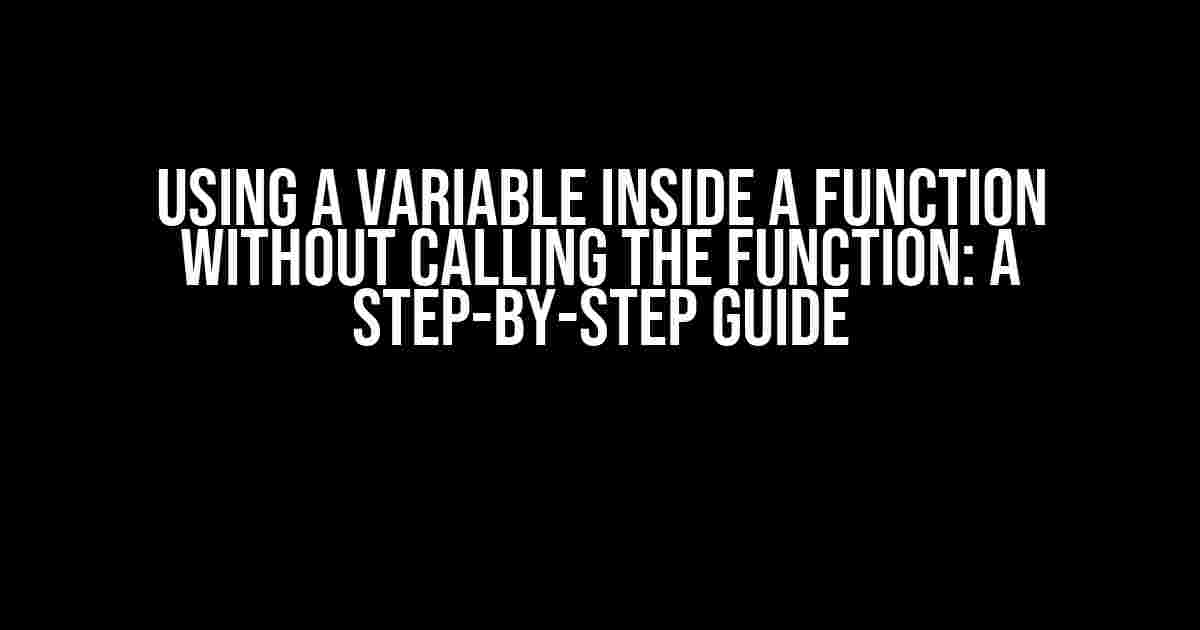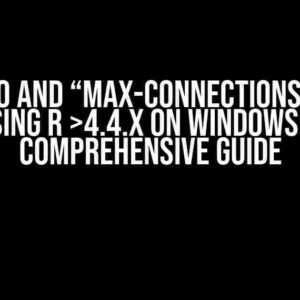As a programmer, you’ve probably encountered a situation where you need to access a variable inside a function without actually calling the function. Sounds contradictory, right? But don’t worry, it’s not as impossible as it seems. In this article, we’ll explore the different ways to achieve this feat, and by the end of it, you’ll be a master of variable manipulation.
Understanding the Problem
Before we dive into the solutions, let’s first understand the problem. Let’s say you have a function that declares a variable, and you want to access that variable outside the function without calling the function. Here’s an example:
function myFunction() {
let myVariable = "Hello, World!";
}
If you try to access `myVariable` outside the function, you’ll get an error. That’s because the variable is scoped to the function and isn’t available globally.
Solution 1: Global Variables
One way to access a variable inside a function without calling the function is to declare the variable globally. Here’s an updated version of the previous example:
let myVariable;
function myFunction() {
myVariable = "Hello, World!";
}
In this example, we’ve declared `myVariable` outside the function, making it a global variable. Now, you can access `myVariable` anywhere in the code, even without calling `myFunction()`.
Pros and Cons
Declaring global variables can be a quick fix, but it has its pros and cons:
- Pros:
- Easier to implement
- Less code changes required
- Cons:
- Global variables can lead to naming conflicts
- They can make the code harder to maintain and debug
Solution 2: Return the Variable
Another way to access a variable inside a function without calling the function is to return the variable from the function. Here’s an updated example:
function myFunction() {
let myVariable = "Hello, World!";
return myVariable;
}
In this example, we’ve returned `myVariable` from the function. Now, you can access the variable by calling the function and storing the result in a new variable:
let result = myFunction(); console.log(result); // Output: "Hello, World!"
Pros and Cons
- Pros:
- More modular and organized code
- Easier to maintain and debug
- Cons:
- Requires calling the function
- Can be less efficient if the function performs complex operations
Solution 3: Using a Higher-Order Function
A higher-order function is a function that takes another function as an argument or returns a function as a result. We can use a higher-order function to access a variable inside a function without calling the function. Here’s an example:
function createMyFunction() {
let myVariable = "Hello, World!";
return function() {
return myVariable;
};
}
let myFunction = createMyFunction();
let result = myFunction();
console.log(result); // Output: "Hello, World!"
In this example, we’ve created a higher-order function `createMyFunction()` that returns a new function. The returned function has access to `myVariable` even when called outside `createMyFunction()`.
Pros and Cons
- Pros:
- More flexible and powerful way to access variables
- Easier to create modular and reusable code
- Cons:
- More complex code structure
- Can be harder to understand and maintain
Solution 4: Using a Closure
A closure is a function that has access to its own scope and the scope of its parent functions. We can use a closure to access a variable inside a function without calling the function. Here’s an example:
function outerFunction() {
let myVariable = "Hello, World!";
function innerFunction() {
return myVariable;
}
return innerFunction;
}
let innerFunction = outerFunction();
let result = innerFunction();
console.log(result); // Output: "Hello, World!"
In this example, we’ve created an outer function `outerFunction()` that returns an inner function `innerFunction()`. The inner function has access to `myVariable` even when called outside `outerFunction()`.
Pros and Cons
- Pros:
- More flexible and powerful way to access variables
- Easier to create modular and reusable code
- Cons:
- More complex code structure
- Can be harder to understand and maintain
Conclusion
In this article, we’ve explored four different ways to access a variable inside a function without calling the function. Each solution has its pros and cons, and the choice depends on the specific requirements and constraints of your project.
| Solution | Pros | Cons |
|---|---|---|
| Global Variables | Easier to implement, Less code changes required | Global variables can lead to naming conflicts, Harder to maintain and debug |
| Return the Variable | More modular and organized code, Easier to maintain and debug | Requires calling the function, Can be less efficient if the function performs complex operations |
| Using a Higher-Order Function | More flexible and powerful way to access variables, Easier to create modular and reusable code | More complex code structure, Can be harder to understand and maintain |
| Using a Closure | More flexible and powerful way to access variables, Easier to create modular and reusable code | More complex code structure, Can be harder to understand and maintain |
Remember, the key to choosing the right solution is to consider the trade-offs and evaluate the requirements of your project. With practice and experience, you’ll become more comfortable with these techniques and be able to write more efficient and effective code.
Final Thoughts
Accessing a variable inside a function without calling the function may seem like a contradiction, but it’s a common problem that can be solved with the right techniques. By understanding the pros and cons of each solution, you can make informed decisions and write better code. Remember to keep your code modular, reusable, and maintainable, and you’ll be well on your way to becoming a master programmer.
Happy coding!
Frequently Asked Questions
Get the scoop on using variables inside functions without calling them!
Can I use a variable inside a function without calling the function?
Unfortunately, no! You can’t use a variable inside a function without calling the function. The variable is only accessible within the scope of the function, and until the function is called, the variable doesn’t exist.
What happens if I try to use a variable inside a function without calling it?
You’ll get an error, my friend! The compiler or interpreter will throw an undefined variable error, because the variable is not in scope. It’s like trying to use a superpower you don’t have – it just won’t work!
Is there a way to make a variable inside a function accessible outside the function?
Yes, but with a twist! You can return the variable from the function and assign it to a new variable outside the function. That way, you can use the value of the variable outside the function. However, the original variable inside the function remains inaccessible.
What if I use a global variable inside a function?
That’s a different story! If you use a global variable inside a function, you can access and modify it both inside and outside the function. However, be careful, as global variables can lead to messy code and unexpected behavior.
Can I use a function’s variable in another function?
Nope, not directly! Each function has its own scope, and variables are not shared between functions. However, you can pass the variable as an argument to another function or return it from the first function and use it in the second function.




